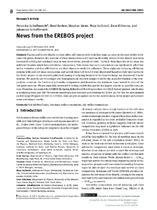| dc.contributor.author | Schaffenroth, Veronika | |
| dc.contributor.author | Barlow, Brad | |
| dc.contributor.author | Geier, Stephan | |
| dc.contributor.author | Vučković, Maja | |
| dc.contributor.author | Kilkenny, Dave | |
| dc.contributor.author | Schaffenroth, Johannes | |
| dc.date.accessioned | 2018-03-13T13:52:20Z | |
| dc.date.available | 2018-03-13T13:52:20Z | |
| dc.date.issued | 2017 | |
| dc.identifier.citation | Schaffenroth, V. et al. (2017). News from the EREBOS project. Open Astronomy, 26: 208 - 213. | en_US |
| dc.identifier.issn | 2543-6376 | |
| dc.identifier.uri | http://dx.doi.org/10.1515/astro-2017-0438 | |
| dc.identifier.uri | http://hdl.handle.net/10566/3578 | |
| dc.description.abstract | Planets and brown dwarfs in close orbits will interact with their host stars, as soon as the stars evolve to become
red giants. However, the outcome of those interactions is still unclear. Recently, several brown dwarfs have been
discovered orbiting hot subdwarf stars at very short orbital periods of 0.065 - 0.096 d. More than 8% of the close hot
subdwarf binaries might have sub-stellar companions. This shows that such companions can significantly affect late
stellar evolution and that sdB binaries are ideal objects to study this influence. Thirty-eight new eclipsing sdB binary
systems with cool low-mass companions and periods from 0.05 to 0.5 d were discovered based on their light curves by
the OGLE project. In the recently published catalog of eclipsing binaries in the Galactic bulge, we discovered 75 more
systems. We want to use this unique and homogeneously selected sample to derive the mass distribution of the companions,
constrain the fraction of sub-stellar companions and determine the minimum mass needed to strip off the
red-giant envelope. We are especially interested in testing models that predict hot Jupiter planets as possible companions.
Therefore, we started the EREBOS (Eclipsing Reflection Effect Binaries from the OGLE Survey) project, which aims
at analyzing those new HW Vir systems based on a spectroscopic and photometric follow up. For this we were granted
an ESO Large Program for ESO-VLT/FORS2. Here we give an update on the the current status of the project and present
some preliminary results. | en_US |
| dc.language.iso | en | en_US |
| dc.publisher | De Gruyter Open | en_US |
| dc.rights | Open Access. © 2017 V. Schaffenroth et al., published by De Gruyter Open. This work is licensed under the Creative Commons
Attribution-NonCommercial-NoDerivatives 4.0 License | |
| dc.subject | Hot subdwarf stars | en_US |
| dc.subject | Low-mass stellar companions | en_US |
| dc.subject | Sub-stellar companions | en_US |
| dc.title | News from the EREBOS project | en_US |
| dc.type | Article | en_US |
| dc.privacy.showsubmitter | FALSE | |
| dc.status.ispeerreviewed | TRUE | |

